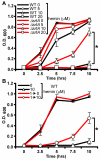A Staphylococcus aureus regulatory system that responds to host heme and modulates virulence
- PMID: 18005689
- PMCID: PMC2083280
- DOI: 10.1016/j.chom.2007.03.001
A Staphylococcus aureus regulatory system that responds to host heme and modulates virulence
Abstract
Staphylococcus aureus, a bacterium responsible for tremendous morbidity and mortality, exists as a harmless commensal in approximately 25% of humans. Identifying the molecular machinery activated upon infection is central to understanding staphylococcal pathogenesis. We describe the heme sensor system (HssRS) that responds to heme exposure and activates expression of the heme-regulated transporter (HrtAB). Inactivation of the Hss or Hrt systems leads to increased virulence in a vertebrate infection model, a phenotype that is associated with an inhibited innate immune response. We suggest that the coordinated activity of Hss and Hrt allows S. aureus to sense internal host tissues, resulting in tempered virulence to avoid excessive host tissue damage. Further, genomic analyses have identified orthologous Hss and Hrt systems in Bacillus anthracis, Listeria monocytogenes, and Enterococcus faecalis, suggesting a conserved regulatory system by which Gram-positive pathogens sense heme as a molecular marker of internal host tissue and modulate virulence.
Figures







Comment in
-
Did bacterial sensing of host environments evolve from sensing within microbial communities?Cell Host Microbe. 2007 Apr 19;1(2):85-7. doi: 10.1016/j.chom.2007.04.002. Cell Host Microbe. 2007. PMID: 18005684
Similar articles
-
The heme sensor system of Staphylococcus aureus.Contrib Microbiol. 2009;16:120-135. doi: 10.1159/000219376. Epub 2009 Jun 2. Contrib Microbiol. 2009. PMID: 19494582 Free PMC article. Review.
-
Signaling and DNA-binding activities of the Staphylococcus aureus HssR-HssS two-component system required for heme sensing.J Biol Chem. 2007 Sep 7;282(36):26111-21. doi: 10.1074/jbc.M703797200. Epub 2007 Jul 16. J Biol Chem. 2007. PMID: 17635909
-
Staphylococcus aureus HrtA is an ATPase required for protection against heme toxicity and prevention of a transcriptional heme stress response.J Bacteriol. 2008 May;190(10):3588-96. doi: 10.1128/JB.01921-07. Epub 2008 Mar 7. J Bacteriol. 2008. PMID: 18326576 Free PMC article.
-
Bacterial Nitric Oxide Synthase Is Required for the Staphylococcus aureus Response to Heme Stress.ACS Infect Dis. 2016 Aug 12;2(8):572-8. doi: 10.1021/acsinfecdis.6b00081. Epub 2016 Jul 7. ACS Infect Dis. 2016. PMID: 27626297 Free PMC article.
-
Intracellular metalloporphyrin metabolism in Staphylococcus aureus.Biometals. 2007 Jun;20(3-4):333-45. doi: 10.1007/s10534-006-9032-0. Epub 2007 Mar 27. Biometals. 2007. PMID: 17387580 Review.
Cited by
-
The AirSR two-component system contributes to Staphylococcus aureus survival in human blood and transcriptionally regulates sspABC operon.Front Microbiol. 2015 Jul 3;6:682. doi: 10.3389/fmicb.2015.00682. eCollection 2015. Front Microbiol. 2015. PMID: 26191060 Free PMC article.
-
Characterization of a novel two-component regulatory system, HptRS, the regulator for the hexose phosphate transport system in Staphylococcus aureus.Infect Immun. 2015 Apr;83(4):1620-8. doi: 10.1128/IAI.03109-14. Epub 2015 Feb 2. Infect Immun. 2015. PMID: 25644013 Free PMC article.
-
Identification of a CO2 responsive regulon in Bordetella.PLoS One. 2012;7(10):e47635. doi: 10.1371/journal.pone.0047635. Epub 2012 Oct 24. PLoS One. 2012. PMID: 23112828 Free PMC article.
-
A Small Membrane Stabilizing Protein Critical to the Pathogenicity of Staphylococcus aureus.Infect Immun. 2020 Aug 19;88(9):e00162-20. doi: 10.1128/IAI.00162-20. Print 2020 Aug 19. Infect Immun. 2020. PMID: 32571989 Free PMC article.
-
Overcoming the heme paradox: heme toxicity and tolerance in bacterial pathogens.Infect Immun. 2010 Dec;78(12):4977-89. doi: 10.1128/IAI.00613-10. Epub 2010 Aug 2. Infect Immun. 2010. PMID: 20679437 Free PMC article. Review.
References
-
- Bader MW, Sanowar S, Daley ME, Schneider AR, Cho U, Xu W, Klevit RE, Le Moual H, Miller SI. Recognition of antimicrobial peptides by a bacterial sensor kinase. Cell. 2005;122:461–472. - PubMed
-
- Bae T, Schneewind O. Allelic replacement in Staphylococcus aureus with inducible counter-selection. Plasmid. 2005 - PubMed
-
- Beier D, Gross R. Regulation of bacterial virulence by two-component systems. Curr. Opin. Microbiol. 2006;9:143–152. - PubMed
Publication types
MeSH terms
Substances
Grants and funding
LinkOut - more resources
Full Text Sources
Other Literature Sources
Molecular Biology Databases

